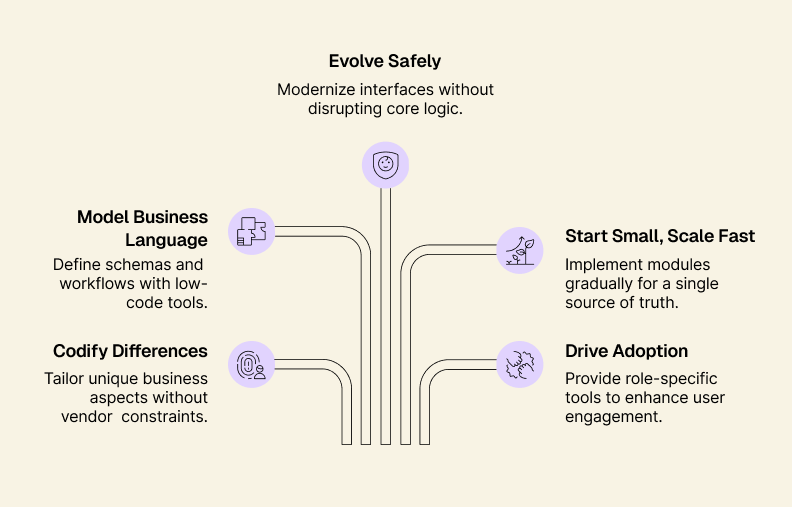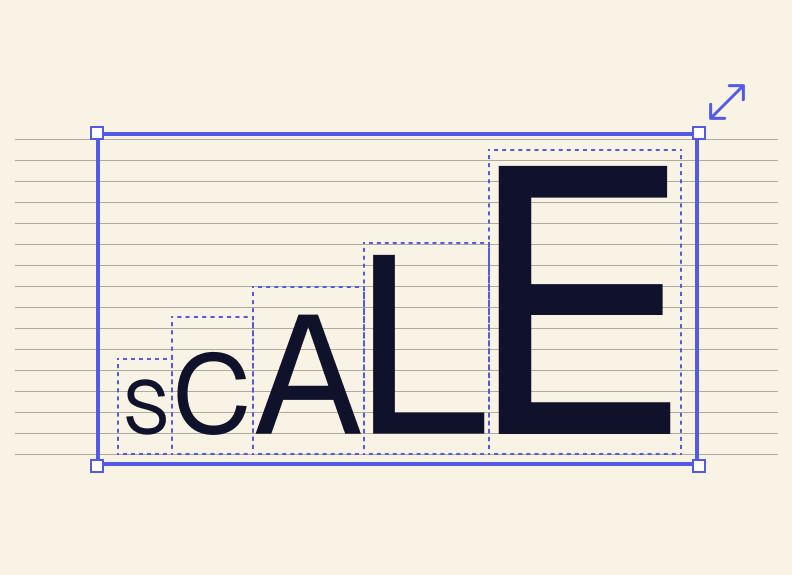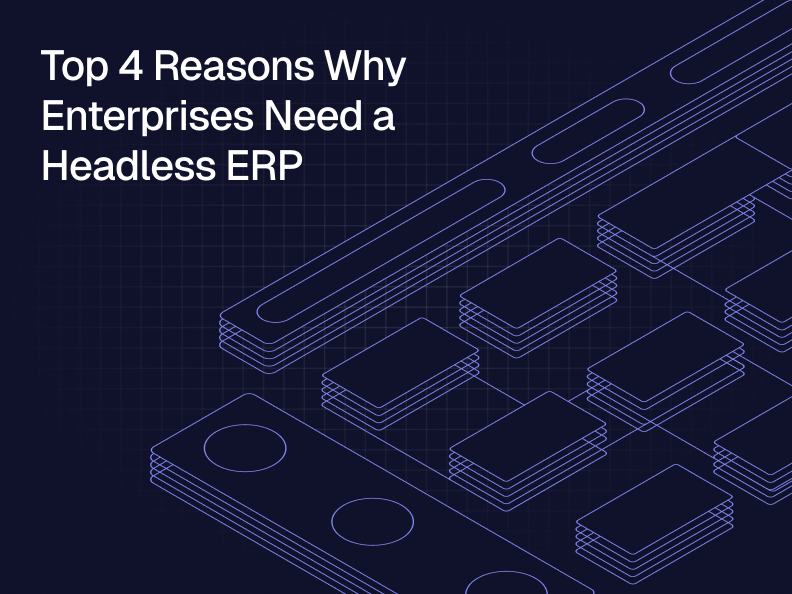In an age where agility and customization are key to thriving in the business world, enterprises are increasingly turning towards Headless ERP (Enterprise Resource Planning) systems. One of the major drawbacks of traditional ERP systems is their rigidity. They often come with a one-size-fits-all interface that can be challenging to adapt to specific business needs.
A Headless ERP system separates the back-end data processing from the front-end user interface, providing unparalleled flexibility and efficiency. This means you can tailor the ERP system to your unique processes and requirements, rather than reshaping your operations to fit the confines of your software. Here’s a look at the top four reasons why your enterprise should consider adopting a Headless ERP.
The 4 Core Advantages of Headless ERP
Here are four practical ways a composable, API‑first ERP outperforms monoliths in the real world:
1. Unmatched Flexibility and Customization
The concept of unmatched flexibility and customization is at the heart of what makes Headless ERP systems so revolutionary. This aspect fundamentally changes how businesses can use and benefit from their ERP solutions. Let's delve deeper into this aspect to understand why it's a game-changer for enterprises.

Traditional ERP systems often require businesses to modify their processes to fit the software’s limitations. In contrast, Headless ERPs allow for extensive tailoring to accommodate unique existing business processes and needs.
This means that businesses can design the system to match their specific workflows, operational structures, and data management requirements, leading to a more efficient and effective use of the ERP system—without being constrained by software limitations. With a Headless ERP, updates and improvements to the system can be made more frequently and with less disruption to the business. Since the front-end and back-end are decoupled, updates to one component can be carried out without significantly impacting the other, ensuring that the system remains up-to-date with the latest features and security measures.
2. Easy Integration with Tools
Today's enterprises don't operate in isolation; they use a myriad of software solutions that need to work in harmony. Headless ERPs excel in this area, offering superior integration capabilities with other tools and systems that you love to use, such as CRM software, e-commerce platforms, and various business intelligence tools. This integration ensures a more unified and efficient operation, streamlining processes, and reducing the likelihood of errors caused by siloed systems. Let's explore why the integration capabilities of Headless ERP systems and how they benefit the enterprise.

Headless ERP systems are designed to easily connect with a wide array of external applications and systems. This includes everything from Customer Relationship Management (CRM) software, Supply Chain Management (SCM) systems, to e-commerce platforms and more. The use of standard APIs (Application Programming Interfaces) and web services in Headless ERPs facilitates this seamless integration, allowing different systems to communicate and share data effectively. This interoperability is essential for creating a cohesive and efficient IT ecosystem within the company. The flexibility of Headless ERP systems extends to their ability to integrate seamlessly with other third-party applications and systems that you use today.
Headless ERPs are future-proof. As new technologies emerge, like AI, machine learning, or advanced data analytics, businesses can integrate these into their existing ERP system without a complete overhaul.
"Headless ERPs are future-proof"
This ability to continuously evolve and embrace new technologies keeps enterprises at the forefront of innovation, ensuring they are always leveraging the best tools to drive their business forward. Businesses can leverage these technologies to enhance their ERP functionality, like incorporating predictive analytics for better decision-making or using IoT for real-time asset tracking and management.
3. Scaling Up to Meet Growth Demands
Growth and change are constants in business, and your ERP system should be able to scale with you. Traditional ERPs can be limiting when it comes to scaling up or down, but Headless ERPs are designed for scalability. With the front-end and back-end decoupled, scaling one aspect doesn’t necessarily mean overhauling the entire system. This adaptability makes it easier for businesses to respond to market changes, growth opportunities, or shifts in demand without major disruptions or costly system upgrades. Let's uncover the different dimensions of how scalability contributes to fostering business growth.

As businesses grow, they often face new challenges and opportunities that require changes in their operational processes and systems. The modular nature of Headless ERP systems is a key factor in their scalability. Instead of a monolithic structure, Headless ERPs are built with separate ERP modules that can be added, removed, or upgraded as needed.
"Headless ERPs are built with separate modules that can be added, removed, or upgraded as needed"
This modular approach allows for incremental upgrades and changes, enabling businesses to adapt their ERP system gradually, without major disruptions to their operations. This flexibility ensures that the ERP system can evolve in tandem with the business, providing consistent support and functionality.
Scaling a business's operations often involves significant investment. However, the scalability of Headless ERP systems can help mitigate these costs. By allowing businesses to add only the modules and functionalities they need, when they need them, Headless ERPs provide a more cost-effective scaling solution compared to traditional ERP systems, which may require purchasing extensive, expensive packages to obtain the necessary functionality.
As businesses grow, they often experience increases in transaction volumes and data complexity. Headless ERP systems are designed to handle these increases efficiently. The decoupled architecture means that the system can manage more data and more complex processes without a corresponding decrease in performance. This capability is essential for ensuring that business operations remain smooth and efficient, even as the scale of operations grows.
4. Innovative User Experience
The fourth key advantage of Headless ERP Systems is the enhanced user experience they offer. This aspect is critically important, as the usability and intuitiveness of an ERP system can significantly impact employee productivity and satisfaction. Let's examine how a Headless ERP enhances user experience.

In traditional ERP systems, users often encounter a one-size-fits-all interface that might not align with their specific job functions. In contrast, Headless ERPs allow for the creation of bespoke interfaces tailored to the unique needs of different user roles within the organization. Custom-tailored interfaces that align with specific user roles and processes can significantly streamline the learning curve for new users. Interfaces can be more intuitive, visually appealing, and easier to navigate.
This user-centric design approach can reduce the learning curve for new users and increase the overall adoption rate of the ERP system across the organization. For example, a finance team could have an interface optimized for financial reporting and analysis, while the sales team could have a dashboard focused on customer relationship management and sales metrics. This customization ensures that each user has the tools and information they need at their fingertips, improving efficiency and satisfaction.
The decoupled architecture of Headless ERP systems often results in faster and more responsive interactions. The optimization of the front-end in a Headless ERP system can significantly reduce load times. Elements like data entry forms, reports, and dashboards are quicker to load and update, which is vital in reducing wait times and improving overall efficiency. This speed is particularly beneficial for tasks that require real-time data processing and display, such as inventory management and financial reporting. This is particularly important in fast-paced business environments where time is of the essence.
With the separation of the front-end and back-end, businesses can adopt the latest frontend technologies and frameworks as they emerge. Developers have the freedom and empowered to experiment with the latest frontend technologies without risking the integrity of the core ERP functions, thus fostering a culture of innovation.
"Developers have the freedom to experiment with the latest frontend technologies without risking the integrity of the core ERP functions"
This capability ensures that the user interfaces can always leverage cutting-edge technology for better performance, aesthetics, and user experience. This means that the system can be optimized for performance, leading to quicker load times and smoother interactions, which are critical factors in user satisfaction. They can develop or use any front-end technology to create a UI that best suits their specific business processes and user preference.
Final Thoughts
Headless ERP represents a paradigm shift in how businesses approach enterprise resource planning. By providing the agility, scalability, and innovation-friendly environment that modern enterprises need, Headless ERPs are not just a trend but a necessary evolution in the digital age. As businesses continue to evolve, the significance of adopting a Headless ERP approach will undoubtedly continue to grow, marking a new era of enterprise efficiency and adaptability.
The shift towards Headless ERP systems is a testament to the evolving needs of modern businesses. These systems offer flexibility, scalability, superior integration, and an enhanced user experience, making them a compelling choice for enterprises looking to stay competitive in a dynamic business environment. By adopting a Headless ERP, businesses can not only improve their operational efficiency but also position themselves for future growth and success.
Schedule a demo with Tailor to see how a headless, API‑first ERP can fit your workflows, connect your tools, and scale without a rewrite.







